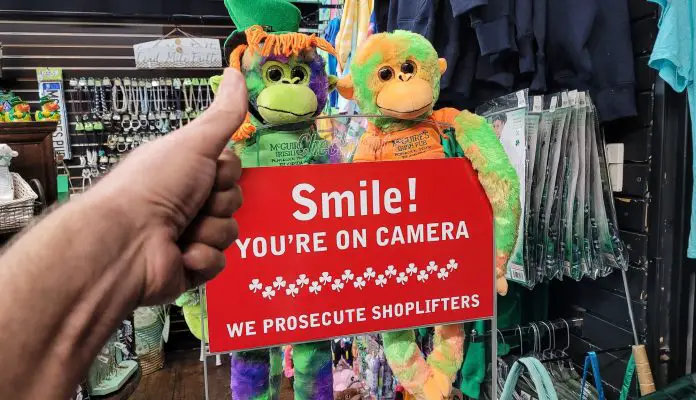Key Takeaways

- Recognize Behavioral Cues: Pay attention to signs such as nervous behavior, loitering, and avoiding eye contact, which can indicate potential shoplifting.
- Monitor Unusual Clothing: Oversized or bulky attire may be used to conceal stolen items; be vigilant about customers dressed in such clothing.
- Identify Distraction Techniques: Shoplifters often use teams to create diversions, so watch for individuals causing distractions while others may attempt to steal.
- Observe Shopping Patterns: Look for prolonged browsing without intent to purchase and frequent returns of items, as these can signal suspicious activity.
- Understand Psychological Profiles: Familiarize yourself with motivations behind shoplifting, including loss-reactive and impulsive behaviors, to better identify risks.
- Train Employees Effectively: Conduct regular training on spotting suspicious behaviors and implementing appropriate responses to create a safer retail environment.
Shoplifting can be a significant issue for retailers, leading to lost profits and increased prices for consumers. Recognizing the signs of a shoplifter is crucial for store owners and employees alike. By understanding these behaviors, you can help protect your business and maintain a safe shopping environment.
From suspicious body language to unusual shopping patterns, there are various indicators that someone might be attempting to steal. Being aware of these signs not only helps in preventing theft but also fosters a more secure atmosphere for honest shoppers. In this article, you’ll discover key signs to watch for and tips on how to respond effectively.
Recognizing Signs of a Shoplifter

Recognizing the signs of a shoplifter is crucial for small businesses to protect profits and maintain safety. Look for these key indicators:
- Nervous Behavior: Pay attention to individuals displaying anxious body language, such as fidgeting or avoiding eye contact. These behaviors can indicate discomfort that may arise from illicit intentions.
- Unusual Clothing: Watch for customers wearing oversized or bulky clothing. Such attire might conceal stolen items, making it easier for shoplifters to avoid detection.
- Frequent Returns: Notice if a customer frequently returns items without a valid reason; this pattern may hint at illicit activity, especially if the items haven’t been purchased at your store.
- Distraction Techniques: Stay aware of groups using distraction methods. One individual may engage an employee while another takes items. This tactic often occurs in retail environments.
- Behavioral Changes: Observe individuals who suddenly change their behavior upon noticing surveillance cameras or employees. A sudden shift to being overly casual or overly cautious can indicate suspicious motives.
- Prolonged Browsing: Keep an eye on shoppers lingering in one area for an extended period without significant progress toward a purchase. Shoplifters often take time to assess their surroundings before committing theft.
- Exiting Without Purchase: Be alert to customers leaving your store without any purchases after spending considerable time inside. This behavior suggests they may have taken items without paying.
Monitoring these signs can help you create a safer environment in your retail space. By staying vigilant, you can minimize losses and foster a more secure shopping experience for your customers.
Common Behavioral Signs
Recognizing the signs of a shoplifter can help small businesses protect their assets and maintain a secure retail environment. Pay attention to these common behavioral signs.
Body Language Indicators
- Loitering: You might notice customers spending excessive time in your store without a clear intent to purchase. Shoplifters often hover in aisles or around displays, indicating potential theft rather than genuine shopping.
- Distracting Behaviors: People engaging in conversations that seem overly animated or unnecessary might aim to create a diversion. If a customer asks multiple questions or requests assistance while their accomplice grabs items, that behavior raises a red flag.
- Large Groups: Groups of customers can cause distractions. Shoplifters often work in pairs or larger gatherings, where one or more individuals engage staff while others steal unnoticed.
Eye Movement and Attention
- Focused Attention: If you observe a customer who seems overly fixated on specific areas of the store, particularly where items are easily concealed, that could indicate suspicious behavior. Shoplifters often scan for opportunities to take products without being detected.
- Avoiding Eye Contact: Shoplifters frequently exhibit reluctance to make eye contact. If customers consistently glance away when you approach, it may suggest they’re hiding their intentions.
By monitoring these behaviors, you can better safeguard your small business from theft, ultimately fostering a secure shopping experience for your customers.
Suspicious Actions
Recognizing suspicious actions in a retail environment helps protect your small business from theft. Certain behaviors can indicate potential shoplifting.
Concealing Items
Shoplifters often use various methods to hide stolen merchandise. They may conceal items in bags, such as backpacks or shopping bags, or even in trolleys with false bottoms. Additionally, they might hide products in their clothing, including pockets or sleeves. Keeping an eye on customers manipulating bags or adjusting their clothing can alert you to possible shoplifting attempts.
Unusual Interactions with Staff
Watch for customers who engage in unusual conversations with your employees. Shoplifters might act overly friendly or ask distracting questions while their accomplices attempt to steal. If a customer spends too much time trying to engage staff without showing genuine interest in purchasing, this behavior may indicate a diversion tactic. Understanding these red flags prepares you to respond effectively and restore focus on security.
Environmental Cues
Understanding environmental cues helps you identify potential shoplifting incidents in your small business. Pay attention to specific aspects of your store’s layout and the areas where theft is more likely to occur.
Store Layout Considerations
Effective store layout can deter shoplifters. Arrange merchandise in a way that minimizes blind spots and ensures clear sightlines. Place high-value items near the cash register or in well-monitored areas. Ensure that displays do not obstruct views of customers. Position staff in locations that allow them to observe customer movements while interacting with shoppers. Strategic layout not only enhances the shopping experience but also increases the likelihood of detecting suspicious behaviors.
High-Risk Areas
Certain areas within your retail space may attract shoplifters more than others. High-risk areas typically include:
- Dressing Rooms: Customers can conceal items in clothing.
- Checkout Lines: Long waits can create opportunities for distractions.
- Entrances and Exits: Unmonitored entrances and exits make it easier for thieves to escape.
Regularly monitor these spaces and consider installing additional security measures like cameras or mirrors to improve visibility. By focusing on these high-risk areas, you can take proactive steps to safeguard your small business from theft.
Psychological Profile
Understanding the psychological profile of a shoplifter helps your small business recognize potential risks. Research identifies several key motivations and types of shoplifters:
- Loss-Reactive: About 27-28% of shoplifters fall into this category. Individuals often respond to past losses or traumas. They’re generally law-abiding citizens who face significant personal losses, prompting them to steal.
- Impulsive: Approximately 20% of shoplifters exhibit high impulsivity and antisocial tendencies. These individuals steal without planning, typically taking inexpensive items. Their actions may seem erratic, which can alert vigilant staff.
- Depressive: Roughly 18% of shoplifters experience clinical depression. They may engage in theft as a coping mechanism, seeking brief relief from feelings of apathy and despair. Recognizing this behavior can be crucial for staff training in responding appropriately.
- Hobbyist: Also around 18%, this group shoplifts for enjoyment. While they maintain good mental health, they lack feelings of guilt associated with their actions. This mindset can make their behavior hard to predict, necessitating close observation.
By examining these psychological profiles, you can enhance your ability to spot suspicious behavior in your retail environment.
Employee Training and Awareness
Employee training plays a crucial role in preventing shoplifting in small businesses. Retail staff should be well-informed about the signs of potential shoplifters. Conduct regular training sessions to emphasize behavioral indicators, such as nervous behavior, inappropriate clothing, and the presence of large bags.
Implement awareness programs that educate employees on how to respond effectively. Employees should engage with customers and foster a welcoming environment while maintaining vigilance. Encourage them to observe customers’ movements, especially within high-risk areas like dressing rooms and checkout lines.
Utilize role-playing scenarios to simulate shoplifting situations. These exercises help staff practice recognizing suspicious behaviors and responding appropriately. Reinforce the importance of communication among team members. Alert them to any observed unusual interactions or distractions that could indicate theft attempts.
Ensure your employees understand the psychological profiles of shoplifters. Knowing the different types—Loss-Reactive, Impulsive, Depressive, and Hobbyist—can sharpen their ability to identify potential risks. A knowledgeable team that can spot and address theft risks creates a safer shopping environment for all customers.
Provide employees with tools and resources, such as checklists or quick-reference guides, to help them remember key signs of shoplifting. By investing in employee training and awareness, you enhance the capability of your small business to mitigate losses and protect your merchandise.
Conclusion
Recognizing the signs of a shoplifter is essential for protecting your business and ensuring a safe shopping environment. By staying alert to suspicious behaviors and environmental cues you can minimize losses and deter theft.
Investing in employee training is key to enhancing your team’s ability to spot potential shoplifting incidents. Encourage staff to engage with customers and observe their actions closely.
With the right knowledge and proactive measures you’ll create a more secure retail space that benefits both your business and your customers.
Frequently Asked Questions
What is the impact of shoplifting on retailers?
Shoplifting significantly affects retailers by leading to lost profits and increased prices for consumers. When retailers incur losses from theft, they often raise prices to compensate, impacting all customers.
What are the signs of a shoplifter?
Signs of a shoplifter include nervous behavior, unusual clothing, prolonged browsing, and unusual shopping patterns. Watching for these behaviors can help retailers identify potential theft.
What are common behavioral signs of shoplifters?
Common signs include loitering, distraction techniques, and avoiding eye contact. Shoplifters may also manipulate bags or clothing to conceal stolen items.
How can store layout prevent shoplifting?
An effective store layout minimizes blind spots and ensures clear sightlines for staff. High-value items should be placed near checkout areas, encouraging surveillance and reducing theft risk.
What are the psychological profiles of shoplifters?
Shoplifters can be categorized as Loss-Reactive, Impulsive, Depressive, or Hobbyist. Understanding these profiles helps retailers identify suspicious behaviors more effectively.
Why is employee training important in preventing shoplifting?
Employee training enhances awareness of shoplifting signs and equips staff with skills to engage customers while remaining vigilant. Regular training prepares employees to respond appropriately to potential theft.
How can retailers create a safer shopping environment?
Retailers can create a safer shopping environment by recognizing suspicious behaviors, improving store layouts, and investing in employee training. These actions help deter theft and protect customers.
Image Via Envato: Beachbumledford, Pressmaster



